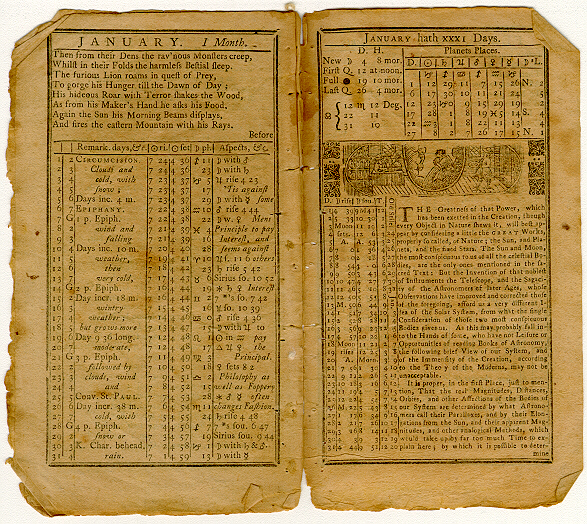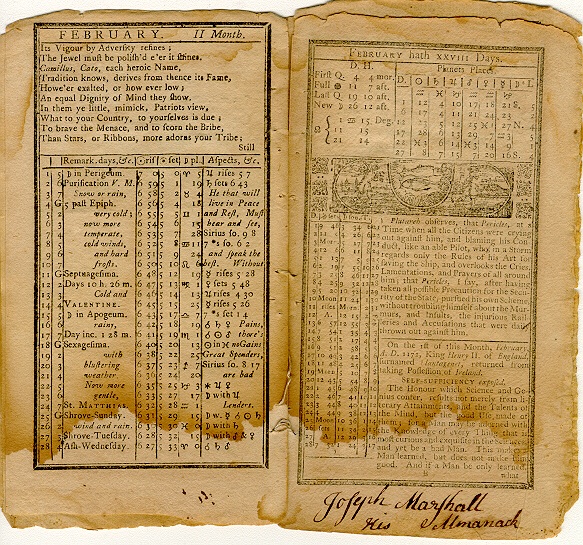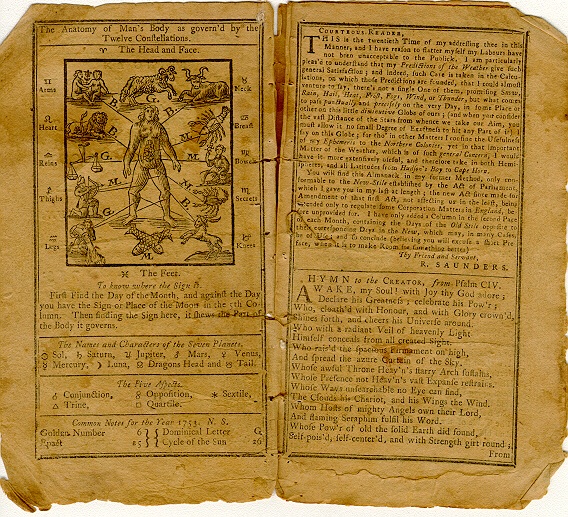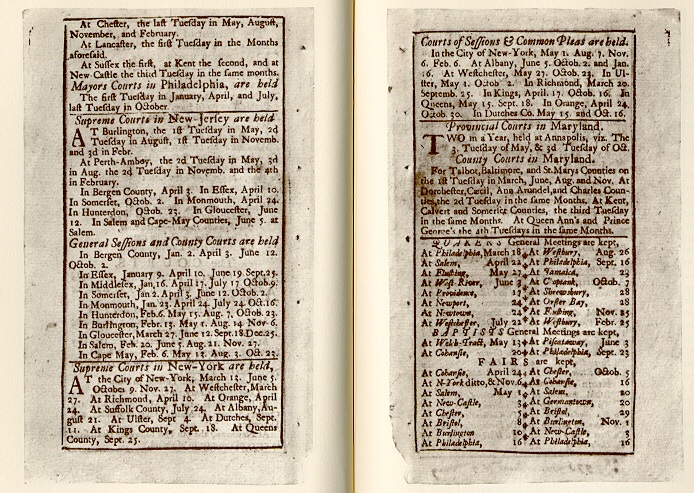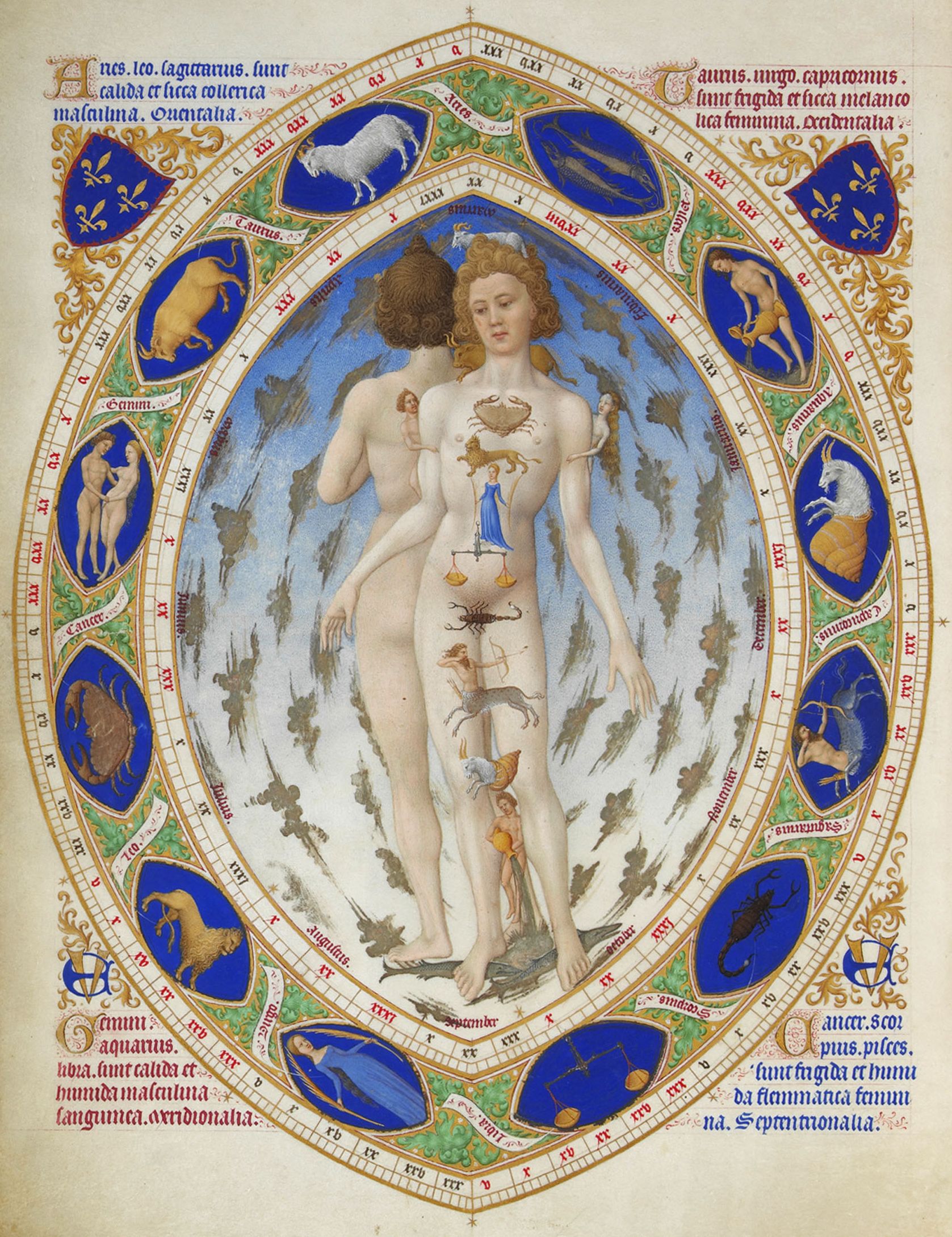The images on this page are from Poor Richard's Almanack An almanac was one of the most important publications in colonial America, and nearly every household owned a copy. It provided people with valuable information as well as entertainment. The value of an almanac is best illustrated by the fourth image on this page, where the owner has written his name, declaring that the almanac is his.
Because almanacs were so important to colonists, printers would pay an astrologer a lot of money to do the calculations -- almost as much as a Justice of the Peace was paid.
Benjamin Franklin was a man of science who was able to do his own calculations. He must have had been somewhat accurate, because his two almanacs, Poor Richard's and Poor Robin's, were some of the most popular in the colonies. You can see how widely these almanacs circulated by looking at the list of courts Franklin published -- Pennsylvania, New York, New Jersey, and Maryland. His almanacs could probably be found as far south as Georgia.
The most important use of an almanac was to predict the weather and to help people know when to plant their crops. There were no weathermen in the colonial period, no daily forcasts to read or listen to. People relied on their almanacs to know the best time to plant their crops and whether it was going to be a wet spring or a dry summer. But without modern science to rely on, people predicted the weather using astrology -- studying the movements of the planets and stars in the belief that they influenced events on earth. Even an illiterate person could read the astrological symbols because it was so important to the agriculture of the colonial period.
The monthly pages of the almanac also contain poems, advice, and historical information. Transcriptions of excerpts are below each image.
January 1753
Then from their Dens the rav'nous Monsters creepIt's possible that Franklin wrote this poem himself, but it's also possible that it came from some other source. In the eighteenth century, printers freely republished works from other sources -- poems, newspaper reports, and even whole books were reprinted without any formal permission from the author or the original publisher. Additionally, many works were published anonymously or under a pseudonym (a "pen name" such as Franklin's "R. Saunders"), and so no one would have known whom to credit. As a result, we have no idea who wrote this poem or where it might have come from.
Whilst in their Folds the harmless bestial sleep.
The furious Lion roams in quest of Prey.
To gorge his Hunger till the Dawn of Day;
His hideous Roar with Terror shakes the Wood,
As from his Maker's Hand he asks his Food.
Again the Sun his morning Beams displays,
and fires the eastern Mountain with his Rays.
|
[Day of the Month] |
[Day of the week, from 1 to 7, with 1 being Sunday. Sunday, is represented by a G, presumably for God's day.] |
Remark, days, &c. |
|
|
|
Aspects, &c. [notes the locations in the sky of the planets and of other non-zodiac constellations] In this column Franklin notes the locations in the sky of the planets and of other non-zodiac constellations. These, too, had astrological significance that we won't attempt to explain here. The planets Uranus, Neptune, and the dwarf planets Pluto and Ceres hadn't been discovered yet. |
|||
|---|---|---|---|---|---|---|---|---|---|
|
1The left column lists the day of the month. |
2 The second column lists the day of the week, from 1 to 7, with 1 being Sunday. Sunday, though, is represented by a G, presumably for God's day. |
CircumcisionAmong other things in this column, Franklin lists important days in the Christian calendar. The Feast of the Circumcision marks the eighth day after Jesus' birth, the day on which he would have been circumcised. |
7 |
24 |
4 |
36 |
11 |
with |
|
|
2 |
3 |
Clouds and |
7 |
24 |
4 |
36 |
23 |
with |
|
|
3 |
4 |
7 |
23 |
4 |
37 |
5 |
rise 4 23Jupiter rises at 4:23. |
||
|
4 |
5 |
7 |
23 |
4 |
37 |
17 |
'Tis against |
||
|
5 |
6 |
Days inc.4 m.The length of the day (between sunrise and sunset) is increasing by 4 minutes per day. |
7 |
23 |
4 |
37 |
29 |
with |
|
|
6 |
7 |
EpiphanyEpiphany is the twelfth day after Christmas, in Christian tradition the day the Wise Men arrived in Bethlehem to find the baby Jesus. An epiphany is a sudden and dramatic realization, and Epiphany in the Christian calendar marks the day when Jesus was revealed as the son of God., |
7 |
22 |
4 |
38 |
10 |
rise 4 44 |
|
|
7 |
G |
1 p. Epiph.The first Sunday after Epiphany. The Christian calendar counts each Sunday after Epiphany until the beginning of Lent and the Easter season on Ash Wednesday, and some churches have special services, music, or readings for each week. |
7 |
22 |
4 |
38 |
22 |
w. |
|
|
8 |
2 |
wind and |
7 |
21 |
4 |
39 |
4 |
Principle to pay |
|
|
9 |
3 |
7 |
21 |
4 |
39 |
16 |
Interest, and |
||
|
10 |
4 |
Days inc. 10 m. |
7 |
20 |
4 |
40 |
28 |
seems against |
|
|
11 |
5 |
weather, |
7 |
19 |
4 |
41 |
10 |
? others |
|
|
12 |
6 |
7 |
18 |
4 |
42 |
23 |
rise 5 42 |
||
|
13 |
7 |
7 |
17 |
4 |
43 |
6 |
Sirius so. 10 52Sirius, a bright star, appears in the southern sky at 10:52. |
||
|
14 |
G |
2 p. Epiph. |
7 |
16 |
4 |
44 |
19 |
* |
|
|
15 |
2 |
Days incr. 18 m. |
7 |
16 |
4 |
44 |
2 |
7 *'s so. 7 427 *'s represents the Seven Stars or Pleiades, a bright cluster of seven stars. |
|
|
16 |
3 |
wintry |
7 |
15 |
4 |
45 |
16 |
so. 10 39 |
|
|
17 |
4 |
7 |
14 |
4 |
46 |
0 |
rise 4 36 |
||
|
18 |
5 |
7 |
13 |
4 |
47 |
15 |
with |
||
|
19 |
6 |
Day 9 36 long |
7 |
12 |
4 |
48 |
1 |
in |
|
|
20 |
7 |
moderate; |
7 |
12 |
4 |
48 |
17 |
the |
|
|
21 |
G |
3 p. Epiph. |
7 |
11 |
4 |
49 |
3 |
Principal. |
|
|
22 |
2 |
followed by |
7 |
10 |
4 |
50 |
18 |
sets 8 2 |
|
|
23 |
3 |
7 |
9 |
4 |
51 |
2 |
Philosophy as |
||
|
24 |
4 |
7 |
8 |
4 |
52 |
15 |
well as Foppery |
||
|
25 |
5 |
Conv. St. Paul.A Christian celebration marking the conversion of St. Paul the Apostle. |
7 |
7 |
4 |
53 |
28 |
* |
|
|
26 |
6 |
Day incr. 38 m. |
7 |
6 |
4 |
54 |
11 |
changes Fashion. |
|
|
27 |
7 |
cold, with |
7 |
5 |
4 |
55 |
24 |
rise 4 48 |
|
|
28 |
G |
4 p. Epiph. |
7 |
4 |
4 |
56 |
7 |
7 *'s sou. 6 47 |
|
|
29 |
2 |
snow or |
7 |
3 |
4 |
57 |
17 |
Sirius sou. 9 44 |
|
|
30 |
3 |
K. Char. behend. |
7 |
2 |
4 |
58 |
1 |
with |
|
|
31 |
4 |
rain. |
7 |
1 |
4 |
59 |
13 |
with |
|
The Greatness of the Power, which
has been exerted in the Creation, through every Object in Nature shews it, will best appear by considering a little the GREAT Works, properly so called, of Nature; the Sun, and Planets, and the fixed Stars. The Sun and Moon, the most conspicuous to us of all the celestial Bodies, are the only ones mentioned in the sacred Text Franklin is referring to the Bible.: But the Invention of the noblest of Instruments the Telescope, and the Sagacity of the Astronomers of later Ages, whose Observations have improved and corrected those of the foregoing, afford us a very different Idea of the Solar SystemFranklin is referring to the relatively new idea that the earth and other planets revolve around the sun, while only the moon revolves around the earth. Until the 1500s, Europeans, following the writings of the ancient astronomer Ptolemy, believed that sun, moon, planets, and stars revolved around a motionless earth. In 1543, Nicolaus Copernicus published his theory that the earth and the five planets then known -- Mercury, Venus, Mars, Jupiter, and Saturn -- revolved around the sun. Copernicus' ideas were highly controversial in Europe, because they opposed the teachings of the Catholic Church. Galileo, famously, was arrested for publishing works agreeing with him after Galileo used his telescope to see the moons of Jupiter in orbit around that planet. Other astronomers and scientists refined these ideas, and they gradually gained acceptance. It's interesting that his explanation of astronomy continues in the next paragraph with definitions of highly technical language. In an age when few people went to school at all, Franklin's almanac was an important source for this kind of educational material -- and, apparently, his readers were interested in learning some "real" science!, from what the single Consideration of those two most conspicuous Bodies gives us. As this may probably fall into the Hands of some, who have not Leisure or Opportunities of reading Books of Astronomy, the following brief View of our System, and of the Immensity of the Creation, according to the Theory of the Moderns, may not be unacceptable.
It is proper, in the first Place, just to mention, That the real Magnitude, Distances, Orbits, and other AffectionsIn this context, affection means a property, quality, or attribute. of the Bodies of our System are determined by what Astronomers call the Parallaxes, and by their Elongations from the Sun, and their apparent magnitudes, and other analogical Methods, which would take up by far too much Time to explain here; by which it is possible to determine...
February 1759
Its Vigour by Adversity refines;
The Jewel must be polish'd e'er it shines.
Camillus, Cato,Camillius and Cato are figures in Ancient Roman History. Both were known for their bravery and patriotism. each heroic Name,
Tradition knows, derives from thence its Fame
Howe'er exalted, or how ever low;
As equal Dignity of Mind they show
In them ye little, mimick, Patriots view,
What to your country, to yourselves is due;
To brave the Menace, and to scorn the Bribe,
Than Stars, or Ribbons, more adorns your Tribe
PlutarchPlutarch was a Greek historian who lived from 46 C.E. to 120 C.E. observes,
that PericlesPericles was an influential Greek statesman or leader who lived in Athens from 495 B.C.E. to 429 B.C.E., at a Time when all the Citizens were crying out against him, and blaming his Conduct, like an able Pilot, who, in a Storm regards only the Rules of his Art for saving the Ship, and overlooks the Cries, Lamentations, and Prayers of all around him; that Pericles, I say, after having taken all possible Precaution for the Security of the State,The 1700s was known as the Age of Reason or the Enlightenment. Europeans became interested in science and scientific exploration in a way that they had not been during the previous centuries. As part of this explosion of ideas and interest in scientific thought, people became fascinated with the Greeks and the Romans. Europeans believed they were living in a time that was similar to the golden ages of Rome and Greece. They created works of arts that depicted famous people and scenes from Roman history, and they sometimes painted contemporary people, including men such as Benjamin Franklin and George Washington, as though they were Roman and Greek heroes. Because of the popularity of Greek and Roman history and mythology, Franklin's audiences would have been familiar with these stories and characters. Like much of what appears in the alamanac, this story seems to have been chosen for its moral or political message. pursued his own Scheme, without troubling himself about the Murmurs, and Insults, the injurious Railleries and Accusations that were daily thrown out against him.
On the 1st of this Month, February,
A.D. 1172, King Henry II of England surnamed Plantagenet, returned from taking Possession of Ireland.
Self-Sufficiency exposed
The Honour which Science and GeniousGenius confer, results not merely from literary Attainments, and the Talents of the Mind, but the good Use made of them; for a Man may be adorned with the Knowledge of every Thing that is most curious and exquisite in the Sciences, and yet be a bad Man. This makes a Man learned, but does not make him good. And if a Man be only learned...
Christianity and the Occult
Although we tend to think of colonial America as a deeply religious place, church attendance actually decreased throughout the colonial period. By 1760, fewer than 15 percent of adults belonged to a church. Church attendance was at its lowest point just before the Revolution.
But although people did not attend church, Christianity was part of the popular culture. Most people, white and black, would have been familiar with biblical stories and poems even if they might not know the finer points of Christianity.
Because people did not belong to any particular church, they were open to blending different traditions into a popular culture that had pagan influences, such as palm reading and astrology, as well as Christian traditions such as the baptism of children.
Almanacs blended the Occult and Christian traditions. You can see the pagan influences in the astrological symbols in the pages above and in the Man of Signs, below; and the Christian influence is clear from the quotations from the Bible.
The Man of Signs
The Man of Signs is perhaps the most confusing image in almanacs. Before the 1800s, people had a very different understanding of the body. They believed that the weather and the alignment of the sun, moon, and stars could affect a person's health. People believed that the world was made up of four elements -- water, fire, earth, and air. The human body had four humors -- fluids -- that controlled its function, each corresponding to one of the four elements: blood (air), phlegm (water), black bile (earth), and yellow bile (fire). Each humor was in turn related to a particular temperament, so a person with more yellow bile (fire) might have a warmer body and a temper, while a person who had more phlegm (water) might be cooler in temperament. If the humors or elements became unbalanced, disease might be the result.
The four elements also corresponded with astrological signs. Parts of the body were also believed to be governed, or more powerful, at different parts of the year. People read these astrological signs to know how their health might change throughout the year. Transcriptions of these pages are below.
1753 Introduction
To know where the Sign is.
First Find the Day of the Month, and against the Day you have the Sign or Place of the Moon in the 5th Column. Then finding the Sign here, it shews the Part of the Body it governs.
Courteous Reader,
This is the twentieth Time of my Addressing thee in this Manner, and I have reason to flatter myself my Labours have not been unacceptable to the Publick. I am particularly pleas'd to understand that my Predictions of the Weather give such general satisfaction; and indeed, such Care is taken in the Calculations, on which those Predictions are founded, that I could almost venture to say there's not a single One of them, promising Snow, Rain, Hail, Heat, Frost, Fogs, Winds, or Thunder, but what comes to pass punctually and precisely on the Day, in some Place or other on this little diminutive Globe of ours; (and when you consider the vast Distance of the Stars from whence we take our Aim, you must allow it no small Degree of Exactness to hit any Part of it)Franklin is making a joke. Obviously, on any given day somewhere on the planet it is raining or snowing or the sun is shining. I say on this Globe; for tho' in other Matters I confine the Usefulness of my Ephemeris to the Northern Colonies, yet in that important matter of the Weather, which is of such general Concern, I would have it more extensively useful, and therefore take in both Hemispheres, and all Latitudes from Hudson's Bay to Cape Horn.
You will find this Almanack in my former Method, only conformable to the New stile established by the Act of Parliament, which I gave you in my last at length;The calendar we use today is called the Gregorian calendar, named after Pope Gregory XIII. In the 1500s, it was becoming clear to Europeans that the Julian calendar they had used since the days of the Roman Empire was slowly getting out of sync with the seasons. The Julian calendar had 365 days and a leap day every fourth year, and it was remarkably accurate — on average, it differed from the true solar year (the time required for the earth to revolve once around the sun) by only 11½; minutes per year. But after 1500 years, that tiny difference added up. To correct that error, the Gregorian calendar eliminates the leap year in years ending in 00, unless they are divisible by 400. So 2000 was a leap year, but 2100 won't be. The Gregorian calendar is accurate to within 26 seconds a year. To make up the days lost over the centuries, when Pope Gregory ordered the new calendar to be implemented in 1582, he also ordered that ten days simply be dropped. Once again, the calendar was in sync with the seasons. But the sixteenth century was the time of the Protestant Reformation, and not all nations followed the Pope's decree. England didn't adopt the Gregorian calendar until 1751, by which time it had to drop eleven days from the calendar to catch up to the rest of Europe. the new Act once made for Amendment of the first Act, not affecting us in the least, being Intended only to regulate the Corporation Matters in England, before unprovided for. I have only added a Column in the Second Page of each month, containing the Days of the Old Stile opposite to their corresponding Days in the New, which may, in many Cases, be of Use; and so conclude (believing you will excuse a short preface, when it is to make Room for something better)
Thy Friend and Servant, R. Saunders.R. Saunders was a pseudonym (an alias or pretend name used by an author) of Benjamin Franklin. The original Richard Saunders was a well-known astrologer who lived in England during the 1600s. The use of this name by Franklin shows us how much colonists in America shared with people of England.
Hymn to the Creator, from Psalm CIV.
Awake, my Soul! With joy they God adore;
Declare his Greatness; celebrate his Pow'r;
Who, cloath'd with Honour, and with Glory crown'd,
Shines forth, and cheers his Universe around.
Who with a radiant Veil of heavenly Light
Himself conceals from all created Sight.
Who rais'd the spacious Firmament on high,
And spread the azure Curtain of the Sky.
Whose awful Throne Heav'n's starry Arch sustains,
Whose presence not Heav'n's vast Expanse restrains
Whose Ways unsearchable no Eye can find,
The clouds his Chariot, and his Wings the Wind.
Whom Hosts of mighty Angels own their Lord,
And flaming Seraphim fulfil his Word.
Whose Pow'r of old the solid Earth did sound,
Self-pois'd, self-center'd, and with Strength grit round;
Court dates and church meetings
One of the most important events in colonial America were court dates. Because of the long distances between towns, a judge or a group of judges traveled around the county and hold trials on different days. It was easier and more efficient to move the judges to the people than to expect people to travel long distances. All of these different courts were responsible for overseeing different parts of the law.
Court days were important for the entire community. People might be involved in a minor incident, such as suing a neighbor for stealing a cow, or serve as a witness in a more violent crime. If they weren't directly involved in a trial, they would probably show up because court day was a form of entertainment. Court days were an opportunity for gossip, trade, and catching up with neighbors.
Franklin has also listed the monthly meetings for Quakers and Baptists, two of the largest religious groups in Pennsylvania. The Quakers and Baptists, as well as other religious groups, held weekly church meetings, and some churches also held monthly meetings. Several congregations would meet at a given location to oversee charity for poor members and to discipline members who had committed sins. Essentially, Franklin is advertising both the secular courts and the religious courts of his day. Transcription of these pages is below.
January 1733
At Chester, the last Tuesday in May, August, November, and February.
At Lancaster, the first Tuesday in the Months aforesaid.
At Suffex the first, at Kent the second, and at New-Castle the third Tuesday in the same months.
Mayors Courts in Philadelphia, are held The first Tuesday in January, April, and July, last Tuesday in October.
Supreme Courts in New-Jersey are held
At Burlington, the 1st Tuesday in May, 2d Tuesday in August, 1st Tuesday in November and 3d in Febr(urary)
At Perth-Amboy, the 2d Tuesday in May, 3d in Aug. the 2d Tuesday in Novemb. and the 4th in February.
In Bergen County, April 3. In Essex, April 10.
In Somerset, Octob. 2. In Monmouth, April 24.
In Hunterdon, Octob. 23. In Gloucester, June 12. In Salem and Cape-May Counties, June 5.
General Sessions and County Courts are held
In Bergen county, Jun 2. April 3. June 12. Octob. 2
In Essex, January 9. April 10. June 19. Sept 25
In Middlesex, jan. 16, April 17, July 17, Octob 23
In Moonmouth, Jan 23, April 24, July 24, Octob. 2
In Hunterdon, Feb. 6. May 15. Aug. 7. Octob. 23.
In Burlington, Febr. 13. May 1 Aug. 14 Nov. 6.
In Glochester, March 27, June 12. Sept 1s. Dec. 25
In Salem, Feb. 20. June 5. Aug. 21. Nov. 27.
In Cape May, Feb. 6. May 13, Augu 8, Octt. 23.
Supreme Courts in New-York are held,
At the City of New-York, March 13, June 5 October 9. Nov. 27.
At Westchester, March 27.
At Richmond, April 10.
At Orange, April 24.
At Suffolk County, July 24.
At Albany, August 21.
At Ulster, Sept. 4.
At Dutches, Sept. 11.
At Kings County, Sept. 18.
At Queens County, Sept. 25.
Courts of Sessions & Common Pleas are held,
In the City of New-York, May 1. Aug. 7. Nov. 6. Feb. 6.
At Albany, June 5. Octob. 2 and Jan. 16.
At Westchester, May 27. Octob. 23.
In Ulster, May 1. Octob. 2.
In Richmond, March 20 Septemb. 25.
In Kings, April 17. Octob. 16.
In Queens, May 15. Sept. 18.
In Orange, April 24 Octob. 30.
In Dutches Co. May 15 and Oct. 16.
Provincial Courts in Maryland.
Two in a Year, held at Annapolis, viz. The 3d Tuesday of Mar. and 3d Tuesday of Octob.
County Courts in Maryland.
For Talbot, Baltimore and St Mary's counties, the first Tuesday in March, June, August, and November.
At Dorchester, cecil, Ann-Arundel, and Charles Counties, the second Tuesday in the same Months.
At Kent, Calvert, and Somerset Counties, the third Tuesday in the same Months.
At Queen Anne's and Prince George's Counties, the fourth Tuesday in the same Months.
Quakers General Meetings are kept.
|
At Philadelphia, March 18 At Salem, April 24 At Flushing, May 27 At West-River, June 3 At Providence, 17 At Newport, 24 At Newton, 24 At Westchester, July 22 |
At Wesbury, Aug. 26 At Philadelphia, Sept. 16 At Jamaica 23 At Choptank, Octob. 7 At Shresburry, 28 At Oyster Bay, 28 At Flushing, Nov. 25 At Westbury, Febr.25 |
Baptists General Meetings are kept
At Welch-Tract, May 13
At Cohansie, 20
At Piscataway, June 3
Philadelphia, Sept. 23
Fairs are kept
|
At Cohansie, April 24 At N-York ditto, & Nov. 6 At Salem May 1 At Chester 5 At Bristol, 8 At Philadelphia, 16 |
At Chester Octob. 5 At Salem, 20 At Germantown 20 At Bristol, 29 At New Castle, 3 At Philadelphia, 16 |
